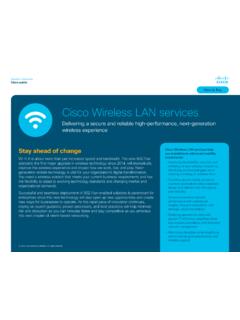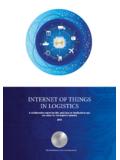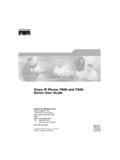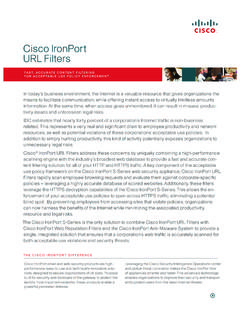Transcription of Data Center Power and Cooling White Paper - …
1 White Paper cisco Unified Computing System Site Planning Guide: Data Center Power and Cooling This document provides a technical overview of Power , space, and Cooling considerations required for successful deployment of IT equipment in the data Center . Topics are introduced with a high-level conceptual discussion and then discussed in the context of cisco products. The cisco Unified Computing System ( cisco UCS ) product line works with industry-standard rack and Power solutions that are generally available for the data Center . cisco also offers racks and Power distribution units (PDUs) that have been tested with cisco UCS and selected cisco Nexus products. This document is intended to inform those tasked with physical deployment of IT equipment in the data Center .
2 It does not discuss equipment configuration or deployment from the viewpoint of a system administrator. 2017 cisco and/or its affiliates. All rights reserved. This document is cisco Public Information. Page 1 of 22. Contents Data Center Thermal Considerations .. 3. Data Center Temperature and Humidity Guidelines .. 3. Best Practices .. 4. Hot-Aisle and Cold-Aisle Layout .. 5. Populating the Rack .. 6. Containment Solutions .. 6. Cable Management .. 7. Relationship between Heat and Power .. 8. Energy Savings in cisco 's Facilities .. 8. cisco Rack Solutions .. 8. cisco Rack Options and Descriptions .. 9. Multi-Rack Deployment 9. Data Center Power Considerations .. 9. Overview .. 10. Power Planning.
3 10. Gather the IT Equipment Power Requirements .. 10. Gather the Facility Power and Cooling 14. Design the PDU Solution .. 15. cisco RP Series Power Distribution Unit (PDU) .. 15. cisco RP Series Basic PDUs .. 15. cisco RP Series Metered Input PDUs .. 16. cisco RP Series PDU Input Plug Types .. 16. For More Information .. 17. Appendix: Sample Designs .. 18. Example 1: Medium Deployment (Rack and Blade Server) .. 18. Example 2: Large Deployment (Blade Server) .. 20. 2017 cisco and/or its affiliates. All rights reserved. This document is cisco Public Information. Page 2 of 22. Data Center Thermal Considerations Cooling is a major cost factor in data centers. If Cooling is implemented poorly, the Power required to cool a data Center can match or exceed the Power used to run the IT equipment itself.
4 Cooling also is often the limiting factor in data Center capacity (heat removal can be a bigger problem than getting Power to the equipment). Data Center Temperature and Humidity Guidelines The American Society of Heating, Refrigeration, and Air Conditioning Engineers (ASHRAE) Technical Committee has created a widely accepted set of guidelines for optimal temperature and humidity set points in the data Center . These guidelines specify both a required and an allowable range of temperature and humidity. ASHRAE. 2015 thermal guidelines are presented in the 2016 ASHRAE Data Center Power Equipment Thermal Guidelines and Best Practices. Figure 1 illustrates these guidelines. Figure 1. ASHRAE and NEBS Temperature and Humidity Limits Although the ASHRAE guidelines define multiple classes with different operating ranges, the recommended operating range is the same for each class.
5 The recommended temperature and humidy are shown in Table 1. Table 1. ASHRAE Class A1 to A4 Recommended Temperature and Relative Humidity Range Property Recommended Value Lower limit temperature F [18 C]. Upper limit temperature F [27 C]. Lower limit humidity 40% relative humidity and F ( C) dew point Upper limit humidity 60% relative humidity and 59 F (15 C) dew point 2017 cisco and/or its affiliates. All rights reserved. This document is cisco Public Information. Page 3 of 22. These temperatures describe the IT equipment inlet air temperature. However, there are several locations in the data Center where the environment can be measured and controlled, as shown in Figure 2. These points include: Server inlet (point 1).
6 Server exhaust (point 2). Floor tile supply temperature (point 3). Heating, Ventilation, and Air Conditioning (HVAC) unit return air temperature (point 4). Computer room air conditioning unit supply temperature (point 5). Figure 2. Example of a Data Center Air Flow Diagram Typically, data Center HVAC units are controlled based on return air temperature. Setting the HVAC unit return air temperatures to match the ASHRAE requirements will result in very low server inlet temperatures, because HVAC. return temperatures are closer to server exhaust temperatures than inlet temperatures. The lower the air supply temperature in the data Center , the greater the Cooling costs. In essence, the air conditioning system in the data Center is a refrigeration system.
7 The Cooling system moves heat generated in the cool data Center into the outside ambient environment. The Power requirements for Cooling a data Center depend on the amount of heat being removed (the amount of IT equipment in the data Center ) and the temperature delta between the data Center and the outside air. The rack arrangement on the data Center raised floor can also have a significant impact on Cooling -related energy costs and capacity, as summarized in the next section. Best Practices Although this document is not intended to be a complete guide for data Center design, it presents some basic principles and best practices for data Center airflow management. 2017 cisco and/or its affiliates. All rights reserved.
8 This document is cisco Public Information. Page 4 of 22. Hot-Aisle and Cold-Aisle Layout The hot-aisle and cold-aisle layout in the data Center has become standard (Figure 3). Arranging the racks into rows of hot and cold aisles minimizes the mixing of air in the data Center . If warm air is allowed to mix with the server inlet air, the air supplied by the air conditioning system must be at an even colder temperature to compensate. As described earlier, lower supply-air temperatures cause increased energy use by the chiller and limit the Cooling efficiency of the data Center by creating hot spots. Figure 3. Hot-Aisle and Cold-Aisle Layout In contrast, not using segregated hot and cold aisles results in server inlet air mixing.
9 Air must be supplied from the floor tile at a lower temperature to meet the server inlet requirements, as shown in Figure 4. Figure 4. Server Inlet Air Mixing 2017 cisco and/or its affiliates. All rights reserved. This document is cisco Public Information. Page 5 of 22. Populating the Rack Racks should be populated with the heaviest and most Power -dense equipment at the bottom. Placing heavy equipment at the bottom helps lower the rack's Center of mass and helps reduce the risk of tipping. Power -dense equipment also tends to draw more air. In the typical data Center , in which air is supplied through perforated floor tiles, placing Power -dense equipment near the bottom of the rack gives that equipment the best access to the coldest air.
10 Unoccupied space in the rack can also cause hot air to penetrate back into the cold aisle. Blanking panels are a simple measure that can be used to prevent this problem, as shown in Figure 5. Figure 5. Using Blanking Panels to Prevent Airflow Short-Circuiting and Bypass In summary, populate racks from the bottom up and fill any gaps between hardware or at the top of the rack with blanking panels. Containment Solutions An effective extension of the hot- and cold-aisle concept is airflow containment. Figure 6 depicts hot-aisle containment. Containment provides complete segregation of the hot and cold air streams, which has the benefit of reducing energy use in the HVAC system by allowing the temperature of the cold air output to be raised.















